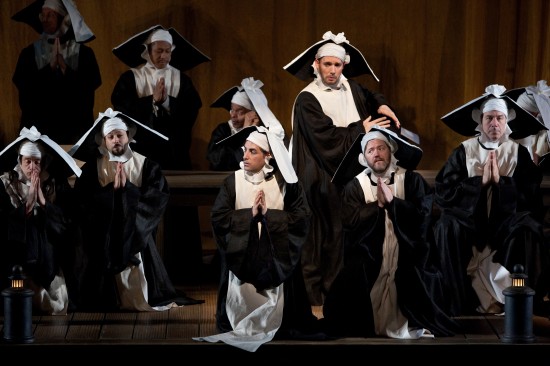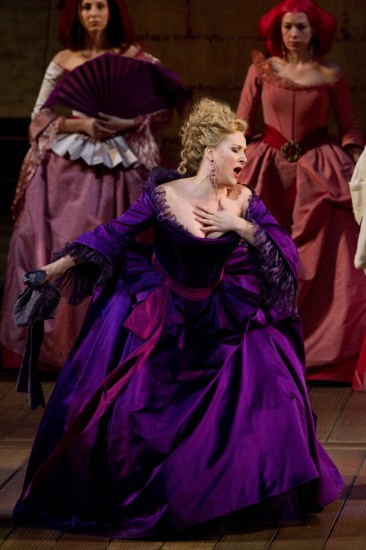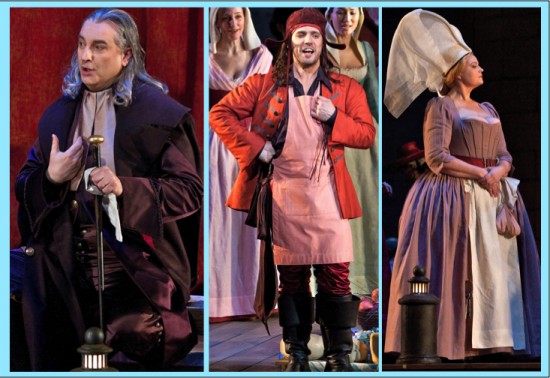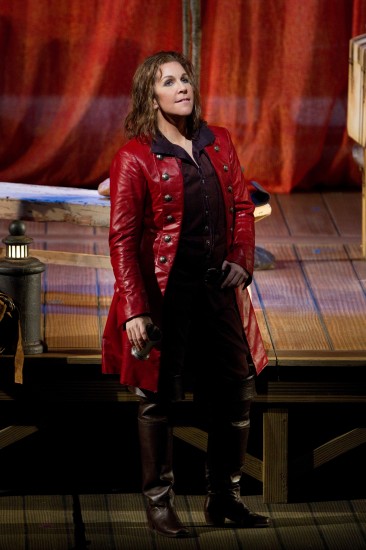We had a real sense of “being there” this morning, April 9 at the Cinemark Theatre in Palo Alto. At approximately five minutes after ten a. m., hostess RenÉe Fleming informed us that half an hour ago (i. e. about 12:30 pm Eastern Daylight Time) tenor Juan Diego Flé³rez had been at his wife’s side as she had given birth to a baby boy – and in a couple of minutes he would be on stage in the title role of today’s opera, Le Comte Ory.

I’m sure that everyone in the theatre – and in hundreds of other theatres throughout the world – felt him-or-herself a member of the Metropolitan Opera family at that moment.

My enjoyment of the opera began before Ms Fleming had finished her 60-second introduction delivered from back stage. She had just told us that rather than simulate a realistic castle in any particular time period, Director Bartlett Sher had chosen to set it as a performance on the stage of a typical opera theatre of 1829, the year Rossini had composed it and the “stage contained many relics from years prior to that.” As she said “relics” a stage hand (costumed as a footman of the period and made up to appear about 107 years old) passed in easy camera range and glared at her.

The camera followed Josef (neither the broadcast nor the program identified him, but it’s easier to write if I give him a name) as he proceeded to the stage where he checked the simulated gas lamps, and made sure that all props were in their proper place. I realized that the curtain was already up and we could hear the cacophony as the orchestra did its final tune up and the typical audience applause as Maestro Maurizio Benini presumably made his usual way to the podium. Meanwhile Josef had finished his checking and pounded three times on the floor with his staff as a signal that it was time to start the orchestra.

There is nothing not to like in this opera. The music is delightful – what else would you expect from Gioachino Rossini? Tenor Juan Diego Flé³rez has a wonderful bel canto voice and is a sensational comic actor. He can convey more meaning with a roll of his eyes than I could in two pages of text. As Comte Ory he has one and only one goal in the opera – to get in bed with

Countess Adèle, a virtuous single lady who is not overly bright. She is beautifully played and sung by soprano Diana Damrau who also has an outstanding bel canto voice and does a great job portraying the ditzy dame. The third member of the love triangle is
Mezzo Joyce DiDonato in the trouser role of the Count’s squire Isolier who is in love with the Countess. His (Her ? – what is the correct pronoun to use for a trouser role? And should one shout bravo or brava in applause? I’ve asked several singers that question and have always received the practical answer that they are delighted to hear either and are not the least bit fussy as to which. But I digress). Ms DiDonato’s bel canto voice and acting make her a worthy partner to the other two.

The three supporting singers all played their parts well, although they were no threat to the three stars. The Tutor (Michele Pertusi) was employed by the Duke to keep an eye on the Count, Raimbaud (StÉphane Degout) was the Count’s personal friend among his knights, and Ragonde (Susanne Resmark) was personal maid to Adèle.
I don’t want to give away any part of the plot. Go see and hear for yourself on Wednesday, April 27 at a theatre near you. But in a scene that is closer to French farce than to anything else in opera the three stars are all in the same bed. It’s total darkness as far as they are concerned, but stage convention allows us to see what’s happening. The hilarity is increased by the fact that the bed is flat during the foreplay, but after all three are on it, Josef comes on stage to crank the bed up to a considerable rake so that we can better see the various groping and counter-groping going on.
Ten pm, and I’m still humming and chuckling.
The Opera Nut
Photos, except as noted: Marty Sohl/Metropolitan Opera
This review by Philip G Hodge appeared in sanfranciscosplash.com on April 15, 2011


